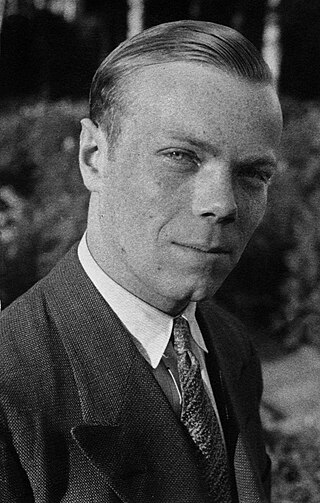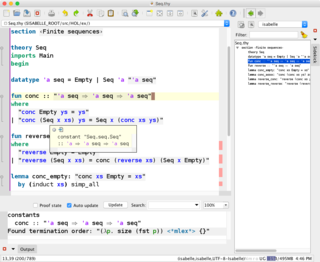First-order logic—also known as predicate logic, quantificational logic, and first-order predicate calculus—is a collection of formal systems used in mathematics, philosophy, linguistics, and computer science. First-order logic uses quantified variables over non-logical objects, and allows the use of sentences that contain variables, so that rather than propositions such as "Socrates is a man", one can have expressions in the form "there exists x such that x is Socrates and x is a man", where "there exists" is a quantifier, while x is a variable. This distinguishes it from propositional logic, which does not use quantifiers or relations; in this sense, propositional logic is the foundation of first-order logic.
Mathematical logic is the study of formal logic within mathematics. Major subareas include model theory, proof theory, set theory, and recursion theory. Research in mathematical logic commonly addresses the mathematical properties of formal systems of logic such as their expressive or deductive power. However, it can also include uses of logic to characterize correct mathematical reasoning or to establish foundations of mathematics.
Gödel's incompleteness theorems are two theorems of mathematical logic that are concerned with the limits of provability in formal axiomatic theories. These results, published by Kurt Gödel in 1931, are important both in mathematical logic and in the philosophy of mathematics. The theorems are widely, but not universally, interpreted as showing that Hilbert's program to find a complete and consistent set of axioms for all mathematics is impossible.

Jacques Herbrand was a French mathematician. Although he died at age 23, he was already considered one of "the greatest mathematicians of the younger generation" by his professors Helmut Hasse and Richard Courant.
In computer science, formal methods are mathematically rigorous techniques for the specification, development, analysis, and verification of software and hardware systems. The use of formal methods for software and hardware design is motivated by the expectation that, as in other engineering disciplines, performing appropriate mathematical analysis can contribute to the reliability and robustness of a design.

The Isabelle automated theorem prover is a higher-order logic (HOL) theorem prover, written in Standard ML and Scala. As an LCF-style theorem prover, it is based on a small logical core (kernel) to increase the trustworthiness of proofs without requiring — yet supporting — explicit proof objects.
Proof theory is a major branch of mathematical logic and theoretical computer science within which proofs are treated as formal mathematical objects, facilitating their analysis by mathematical techniques. Proofs are typically presented as inductively-defined data structures such as lists, boxed lists, or trees, which are constructed according to the axioms and rules of inference of a given logical system. Consequently, proof theory is syntactic in nature, in contrast to model theory, which is semantic in nature.

Logic in computer science covers the overlap between the field of logic and that of computer science. The topic can essentially be divided into three main areas:

In computer science and mathematical logic, a proof assistant or interactive theorem prover is a software tool to assist with the development of formal proofs by human-machine collaboration. This involves some sort of interactive proof editor, or other interface, with which a human can guide the search for proofs, the details of which are stored in, and some steps provided by, a computer.
"Über formal unentscheidbare Sätze der Principia Mathematica und verwandter Systeme I" is a paper in mathematical logic by Kurt Gödel. Submitted November 17, 1930, it was originally published in German in the 1931 volume of Monatshefte für Mathematik und Physik. Several English translations have appeared in print, and the paper has been included in two collections of classic mathematical logic papers. The paper contains Gödel's incompleteness theorems, now fundamental results in logic that have many implications for consistency proofs in mathematics. The paper is also known for introducing new techniques that Gödel invented to prove the incompleteness theorems.
In computer science, in particular in knowledge representation and reasoning and metalogic, the area of automated reasoning is dedicated to understanding different aspects of reasoning. The study of automated reasoning helps produce computer programs that allow computers to reason completely, or nearly completely, automatically. Although automated reasoning is considered a sub-field of artificial intelligence, it also has connections with theoretical computer science and philosophy.
In computer science and mathematical logic, satisfiability modulo theories (SMT) is the problem of determining whether a mathematical formula is satisfiable. It generalizes the Boolean satisfiability problem (SAT) to more complex formulas involving real numbers, integers, and/or various data structures such as lists, arrays, bit vectors, and strings. The name is derived from the fact that these expressions are interpreted within ("modulo") a certain formal theory in first-order logic with equality. SMT solvers are tools that aim to solve the SMT problem for a practical subset of inputs. SMT solvers such as Z3 and cvc5 have been used as a building block for a wide range of applications across computer science, including in automated theorem proving, program analysis, program verification, and software testing.
Logic is the formal science of using reason and is considered a branch of both philosophy and mathematics and to a lesser extent computer science. Logic investigates and classifies the structure of statements and arguments, both through the study of formal systems of inference and the study of arguments in natural language. The scope of logic can therefore be very large, ranging from core topics such as the study of fallacies and paradoxes, to specialized analyses of reasoning such as probability, correct reasoning, and arguments involving causality. One of the aims of logic is to identify the correct and incorrect inferences. Logicians study the criteria for the evaluation of arguments.
Logic Theorist is a computer program written in 1956 by Allen Newell, Herbert A. Simon, and Cliff Shaw. It was the first program deliberately engineered to perform automated reasoning, and has been described as "the first artificial intelligence program". Logic Theorist proved 38 of the first 52 theorems in chapter two of Whitehead and Bertrand Russell's Principia Mathematica, and found new and shorter proofs for some of them.
The CADE ATP System Competition (CASC) is a yearly competition of fully automated theorem provers for classical logic CASC is associated with the Conference on Automated Deduction and the International Joint Conference on Automated Reasoning organized by the Association for Automated Reasoning. It has inspired similar competition in related fields, in particular the successful SMT-COMP competition for satisfiability modulo theories, the SAT Competition for propositional reasoners, and the modal logic reasoning competition.
Charles Gregory Nelson was an American computer scientist.
Z3, also known as the Z3 Theorem Prover, is a satisfiability modulo theories (SMT) solver developed by Microsoft.
Deepak Kapur is a Distinguished Professor in the Department of Computer Science at the University of New Mexico.



